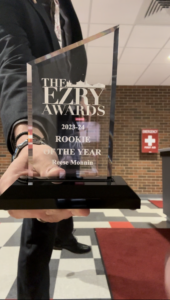Students at the forum two weeks ago on Feb. 13 heard President Frandsen say that the current state of the university is the result of 20 to 30 years of poor financial decisions. What they did not hear were the details of these decisions, the trail that led Wittenberg to the brink of crisis. When the history is unraveled, the complex contributing factors prove there is no singular person, decision or building to blame.
“It is a storm of multiple things,” Adam Parker said, professor and chair of the Budget and Compensation Advisory Committee (BCAC). “It will require us solving several problems simultaneously.” These several problems include: enrollment, retention, the cost of Health, Wellness & Athletics (HWA) facilities and millions in loans that are due within the next few years.
One of the immediate issues pressing the board is the debt that is projected to compile even after the cuts the university has made this year. The deficit from normal operating activities was projected to be $5.3 million this year and nearly $22 million over the next five years. The total cash shortfall for this year (the operating deficit plus debt servicing deficit) was projected to be $10 million, which Frandsen announced at the student forum.
Frandsen also mentioned several contributors to this shortage. Student retention (the percentage of freshmen who return for their sophomore year) has been a particular struggle for the university in recent years. One of the largest drops in retention happened from 2015 to 2016, from 77.8 percent to 71.6 percent. Current retention is 70 percent.
In addition to the ongoing retention issue, the incoming class this year was devastatingly small.
“For the freshmen coming in 2019, an enrollment of 600 would be beyond expectations, 550 would be holding steady, 500 would be weak and 450 would have been disastrous,” Steven Landgraf, professor of economics, said. Wittenberg enrolled 344.
The gap of 150 students (multiplied by the net tuition and room and board fees) resulted in a net loss for the university of approximately $3 million.
According to the minutes from a September 2019 faculty meeting, the biggest factor behind this low enrollment was Wittenberg’s lack of communication during the recruitment process. The minutes state that President Frandsen holds himself responsible for this oversight.
However, one year of miscommunication was not the sole culprit. One of the most imposing threats for Wittenberg’s finances is the millions in bonds and notes (long-term loans) that the university must repay in coming years.
In 2016, Wittenberg restructured its debt with $45 million in bonds.
These loans were justified by recruitment numbers. Karen Hunt, Wittenberg’s executive director of admission in 2016, told the Springfield News-Sun, “We are experiencing a record level of applications to Wittenberg this year, proving that the university continues to be a top-choice school for prospective students and their families.” Despite record-setting admissions, the bond issuance was still accompanied by $6.5 million in cuts across the university that year.
From 2016-2021, Wittenberg has been paying only interest on these loans, and 2016 Vice President for Finance and Administration Randal Freebourn told the Springfield News-Sun that the money would not be used for the $40.5 million HWA, “which is being paid for solely through fundraising and tax credits.” The interest on the HWA debt this year was projected to be $1.9 million.
In 2019, new notes were incorporated into this current debt, totaling $34 million, and The Steemer began to play a larger role in the crisis. The intermediary for the loans, Oppenheimer, reported that “proceeds of the [2019] issue were used to finance the rehabilitation of the historic fieldhouse and athletic facilities located on the University’s campus.” The principal of this note is due in three installments in 2020, 2022 and 2023.
The Steemer has been regarded among many students as one of the leading causes of Wittenberg’s financial issues.
“Everybody talks about The Steemer like it’s this monument to our problems, and it totally is,” Landgraf said. “But even if that wasn’t there, we still would have this huge financial hole.”
Still, the loans issued for The Steemer contribute to this hole. While the $12 million due in 2022 is currently covered by donations and donation pledges, the final $14 million of the HWA debt due in 2023 currently has no source of funding pledged to pay it.
“We got way out of control,” Parker said in reference to The Steemer’s financial situation, “either because some crazy unexpected event happened, or they just negligently did not understand what the costs were going to be. They broke their promise that they weren’t going to use general University funds and they weren’t going to borrow.”
But at the end of the day, this is bigger than The Steemer. It’s bigger than recruitment, retention, and low enrollment. It’s bigger than the board. It’s bigger than Frandsen. Anyone looking to point a finger to a single source of blame will not find what they are looking for.
“Some of the people to blame are no longer here,” Parker said. “Some have apologized. Some don’t know they are to blame. And some people we think that are to blame are actually probably innocent.”
This story is part of a series of investigations on the current financial crisis. The Torch is following up with members of the Wittenberg community to report additional details regarding the future as well as the 20-30 years that led Wittenberg to this point.





